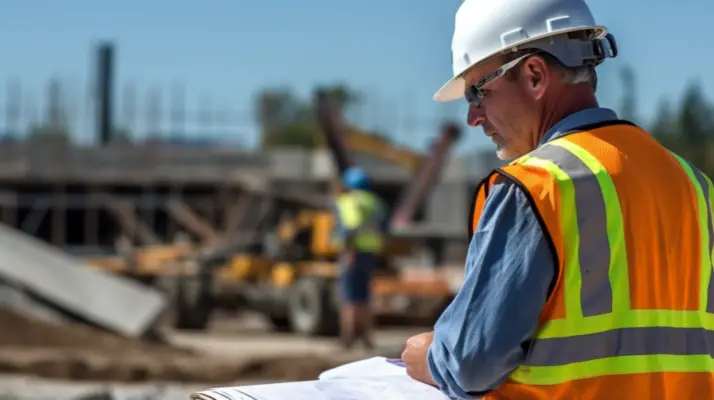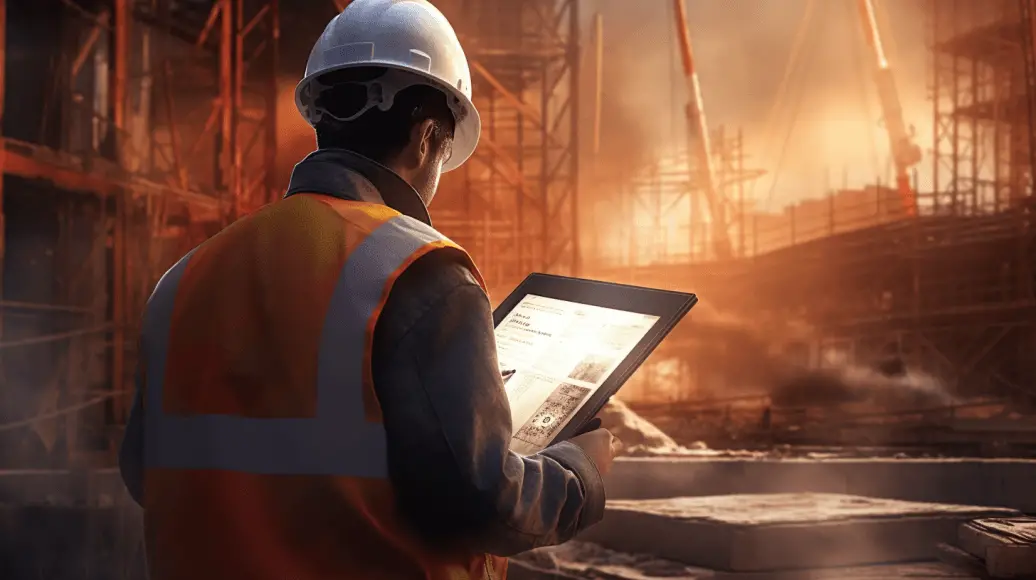Concrete pouring is a critical process in construction, but it also poses various risks that must be carefully assessed. Risk assessment is crucial in identifying, evaluating, and controlling these potential hazards associated with concrete pouring.
This article provides an overview of concrete pouring risk assessment, focusing on hazard communication requirements and the need for respiratory and eye protection.
Firstly, risk assessment is defined as the systematic process of identifying potential hazards, assessing their likelihood and severity, and implementing appropriate control measures to mitigate the identified risks.
Concrete pouring involves analyzing the specific tasks involved in the process and identifying potential hazards such as falls from heights, exposure to harmful chemicals or substances, and accidents involving heavy machinery.
Furthermore, hazard communication requirements are essential for ensuring effective communication about potential hazards associated with concrete pouring.
This includes properly labeling hazardous materials used during concrete mixing or curing processes and providing clear instructions on safely handling these materials.
Lastly, respiratory and eye protection requirements protect workers from airborne particles or chemical splashes during concrete pouring. Adequate personal protective equipment (PPE), including respirators and safety goggles, should be provided to minimize exposure risks.
Conducting a comprehensive risk assessment for concrete pouring activities and implementing necessary safety measures, construction companies can ensure a safer working environment for their workers while minimizing potential accidents or health hazards.

Definition of Risk Assessment
The definition of risk assessment is the systematic process of identifying, analyzing, and evaluating potential hazards in order to determine the likelihood and severity of adverse events occurring.
The concrete pouring risk assessment involves assessing the risks associated with wet concrete, contact with concrete, and exposure to concrete dust.
Potential hazards include chemical burns from contact with wet concrete or concrete dust and respiratory issues caused by inhaling airborne particles.
Hazard communication informs workers on proper safety procedures and protective measures to mitigate these risks. This includes wearing appropriate personal protective equipment such as eye and respiratory protection.
Conducting a comprehensive risk assessment and implementing necessary precautions can minimize the likelihood of injuries such as burns from contact during concrete pouring activities.
Overview of Concrete Pouring Risk Assessment
Concrete pouring involves several hazards that need to be assessed to ensure the safety of workers and the surrounding environment.
These hazards include risks related to working at heights, exposure to harmful chemicals, and the potential for accidents due to heavy machinery and equipment used during the pouring process.
A thorough risk assessment is necessary to identify these hazards, evaluate their potential impact, and implement appropriate control measures to mitigate the risks associated with concrete pouring activities.
Hazards Associated with Concrete Pouring
This focuses on the hazards associated with concrete pouring, specifically regarding contact with concrete and wet cement, contact with reinforcement, awkward postures, manual handling injuries, dust from concrete mixers, mixture placement, and the need for dust-free areas to protect human tissue.
Contact with concrete and wet cement can cause chemical burns and skin irritation. Contact with reinforcement can lead to cuts or puncture wounds.
Awkward postures and manual handling of heavy materials can result in musculoskeletal injuries.
Dust generated during the pouring process can pose a respiratory hazard. Therefore, it is important to establish dust-free areas to protect workers’ health.
Contact with Concrete and Wet Cement
Contact with wet cement can pose significant risks to individuals working on a concrete pouring project.
Concrete placement involves direct contact with the concrete mixture, which contains ingredients such as crystalline silica that can cause respiratory irritation and long-term health issues.
Control measures should be implemented to minimize these risks, such as wearing alkali-resistant gloves and using appropriate respiratory protection.
Proper training and adherence to safety protocols are crucial in preventing injuries and ensuring the well-being of workers.
Contact with Reinforcement
Reinforcement of concrete structures is critical in ensuring their strength and durability.
Contact with reinforcement is an important consideration in the concrete pouring activity, as it poses potential risks to workers’ safety.
Concrete construction guidelines and hazard identification tools should be used to assess and mitigate these risks.
Steel reinforcement sags can lead to accidents on construction sites, highlighting the importance of conducting a thorough concrete pouring risk assessment.
Awkward Postures and Manual Handling Injuries
Awkward postures and manual handling injuries can significantly impact the well-being of workers involved in concrete construction projects. These risks should be considered in a concrete pouring risk assessment to ensure worker safety.
Construction sites often require workers to be uncomfortable handling heavy materials such as concrete mixers, which can strain muscles and joints. In addition, contact with wet concrete can cause burns and irritation to the human skin and tissues.
Access to emergency washing facilities should be provided as part of a safe work method statement for any concrete construction job.
Dust from Concrete Mixers and Mixture Placement
Dust emissions generated by the operation of concrete mixers and the placement of mixtures can pose potential health hazards to workers in the construction industry.
These hazards include exposure to silica dust, commonly found in construction materials.
Construction trade workers involved in concrete work activities are particularly at risk.
The risk assessment file should address safety hazards associated with cement and potential measures to mitigate dust from concrete mixers.
Dust-Free Areas for Human Tissue Protection
To protect human tissue, it is crucial to establish designated dust-free areas within construction sites. These areas are a preventive measure against the common hazards associated with concrete pouring, such as dust inhalation and skin irritation.
Implementing dust-free areas, construction workers can minimize their exposure to harmful particles and reduce the risk of health issues.
This precautionary measure should be included in construction induction training and incorporated into the concrete pumping risk assessment process.
| Common Hazards | Concrete Pumping Services | Assessment of Risk |
|---|---|---|
| Dust Inhalation | Steel Setting | Formwork Failure |
| Skin Irritation | Extra Gloves | – |
This table displays some common hazards related to concrete pouring and their corresponding preventive measures. For instance, dust inhalation can be mitigated by establishing designated dust-free areas and providing extra gloves for workers to protect their skin from irritants.
Regular risk assessments are also essential in identifying potential dangers like formwork failure or inadequate steel setting, allowing for timely corrective actions.
Silica Dust Exposure to Human Skin
It is crucial to address silica dust exposure to human skin to ensure dust-free areas for human tissue protection during concrete pouring.
This issue can be mitigated by providing workers with alkali-resistant gloves, which protect against the harmful effects of silica dust.
Additionally, implementing proper construction contract provisions and enforcing gaps in perimeter protection around construction vehicles can help prevent accidents.
Regular monitoring and evaluation of the drying process should also be conducted as part of the accident investigation process to ensure consumer protection.
- Alkali resistant gloves.
- Construction contract provisions.
- Gaps in perimeter protection.
- Regular monitoring and evaluation.
- Accident investigation process.
Chemical Burns from Contact with Alkali Resistance Gloves
Chemical burns can result from contact with alkali-resistance gloves, posing a significant occupational hazard that demands attention in the risk construction field.
It is essential to carefully consider contract conditions and building work contract complaints to ensure worker safety.
Providing cold drinking water and regular appointments at mining operations can help mitigate the risk of chemical burns.
Additionally, proper training on handling chemicals and using protective equipment like delivery hoppers and daily health checks should be implemented.

Hazard Communication Requirements
This discussion will focus on three key points related to hazard communication requirements in concrete pouring risk assessment.
Firstly, the Safe Work Method Statement (SWMS) plays a crucial role in ensuring the safety of workers by outlining the necessary control measures for all hazards identified in the SWMS.
These control measures minimize risks and prevent accidents during concrete pouring activities.
Additionally, hazard communication training is essential for on-site employees to ensure they are knowledgeable about potential hazards and understand how to communicate and address them effectively.
Safe Work Method Statement (SWMS)
The Safe Work Method Statement (SWMS) outlines the step-by-step procedures for safely conducting concrete pouring activities.
It is a crucial document that ensures workers know the potential hazards associated with the task and provides clear instructions to mitigate these risks.
The SWMS includes three key components:
- Identification of hazards: This involves a comprehensive assessment of potential risks such as slips, trips, falls, exposure to hazardous substances, and equipment malfunctions.
- Risk control measures: The SWMS specifies the measures that must be implemented to minimize or eliminate identified hazards. These may include wearing personal protective equipment (PPE), implementing safe work practices, providing training and supervision, and utilizing appropriate machinery and tools.
- Emergency response procedures: The document also outlines the steps to be taken in case of an emergency or accident during concrete pouring activities. This helps ensure workers are prepared and respond effectively to unforeseen incidents.
Following the guidelines outlined in the SWMS, employers can promote a safer working environment for their employees while carrying out concrete pouring tasks.
Control Measures for All Hazards Identified in SWMS
To ensure the safety of workers, appropriate measures should be implemented to mitigate potential hazards identified in the SWMS for concrete pouring activities. These control measures are crucial in minimizing risks associated with concrete pouring.
Firstly, providing adequate training and instructions to all workers is essential, ensuring they possess the necessary skills and knowledge to carry out their tasks safely.
Secondly, personal protective equipment (PPE) must be provided and worn by workers exposed to hazardous substances or environments at all times.
Additionally, equipment and tools should be regularly inspected and maintained to ensure they are safe.
Furthermore, proper signage and barricades should be installed to indicate restricted areas and prevent unauthorized access clearly.
Finally, emergency procedures should be established and communicated effectively to respond promptly in case of accidents or incidents.
Implementing these control measures can significantly reduce the risk of injuries or accidents during concrete pouring.
Hazard Communication Training for Employees Working on Site
One important aspect of ensuring the safety of employees working on-site involves providing comprehensive hazard communication training.
This training aims to educate workers about the potential hazards during concrete pouring activities and how to communicate these risks to others effectively.
Equipping employees with the necessary knowledge and skills, they are better prepared to identify and report hazards promptly, reducing the likelihood of accidents or injuries.
Hazard communication training typically covers hazard identification, labeling requirements, safety data sheets (SDS), and proper use of personal protective equipment (PPE).
Through this training, employees better understand their roles and responsibilities in maintaining a safe work environment. Regular refresher courses help employees stay updated with changes or new information regarding hazardous substances or procedures.
Overall, hazard communication training plays a crucial role in mitigating risks and promoting a culture of safety on construction sites.
Respiratory and Eye Protection Requirements
Respiratory and eye protection requirements are crucial for ensuring the safety of workers during concrete pouring, as they shield against harmful airborne particles and potential eye injuries caused by splashes or projectiles.
The inhalation of dust and other airborne contaminants can lead to various respiratory illnesses, including lung damage and occupational asthma.
Therefore, workers must wear appropriate respiratory protection to prevent inhalation exposure, such as filtering facepieces or powered air-purifying respirators.
Similarly, eye protection is vital to safeguard against possible eye irritants or flying debris generated during the pouring process. Safety goggles with side or full-face shields should be worn to provide adequate eye protection.
Adherence to these protective measures significantly reduces the risk of respiratory and eye-related hazards, thus promoting worker safety on construction sites.
Frequently Asked Questions
How long does a concrete pouring risk assessment typically take to complete?
A concrete pouring risk assessment typically takes varying durations depending on the project’s complexity and the assessment process’s thoroughness.
Factors such as site conditions, project size, and team expertise can influence the time required for completion.
What are the common hazards associated with concrete pouring that should be assessed?
Common hazards associated with concrete pouring include falls from heights, exposure to hazardous substances such as cement dust and chemicals, manual handling injuries, noise, and vibration exposure, slips and trips, and the risk of being struck by vehicles or equipment on site.
Are there any specific regulations or guidelines that must be followed during a concrete pouring risk assessment?
Specific regulations and guidelines that must be followed during a concrete pouring risk assessment include ensuring compliance with local building codes, OSHA standards for worker safety, and proper personnel training.
What are the main factors to consider when determining the respiratory and eye protection level required for concrete pouring?
When determining the level of respiratory and eye protection required for concrete pouring, key factors to consider include the potential exposure to airborne contaminants, such as dust and chemicals, and the concentration and duration of exposure.
Are any specific training or certifications required for individuals conducting concrete pouring risk assessments?
Training and certifications for individuals conducting concrete pouring risk assessments are not widely mandated.
However, it is recommended that they possess knowledge and experience in construction safety practices, risk assessment methodologies, and relevant regulations to identify and mitigate potential hazards effectively.

Conclusion
Risk assessment is a crucial step in ensuring the safety of concrete pouring activities. Workers can effectively minimize risks and prevent accidents by identifying potential hazards and implementing appropriate control measures.
Hazard communication requirements inform workers about the dangers associated with concrete pouring, while respiratory and eye protection requirements help protect workers from harmful dust particles and chemicals.
Thorough risk assessment practices are essential for creating a safe working environment during concrete pouring operations.

Chris Ekai is a Risk Management expert with over 10 years of experience in the field. He has a Master’s(MSc) degree in Risk Management from University of Portsmouth and is a CPA and Finance professional. He currently works as a Content Manager at Risk Publishing, writing about Enterprise Risk Management, Business Continuity Management and Project Management.

